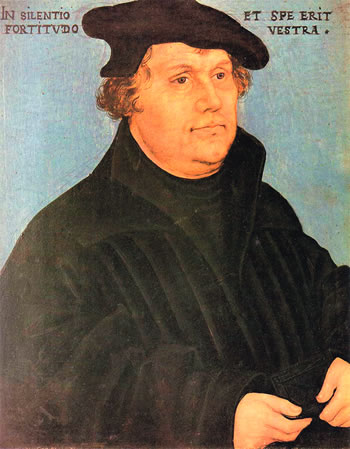Mary and the Reformation (5) – Martin Luther (1483 – 1546) Part 2

by Br Kieran Fenn FMS
Marian Piety
Luther’s concern about appreciation for the message of Mary’s song, the Magnificat, was expressed in the words: “The oftener we sing it the more we silence its true music and meaning.” Throughout his great commentary, he invites the reader into living participation in Mary’s song. “It needs to be pondered in the heart, what it means to be the Mother of God. Was not hers a wondrous soul? We should ‘bless’ Mary, in keeping with her prophecy, all generations shall bless me. Such a blessing is done with all one’s strength and with downright sincerity.” Above all the Magnificat is to be experienced and felt.
 Marian Doctrine
Marian Doctrine
Luther preserved a warm piety towards the Virgin Mary, accepting the traditional doctrines, from ‘Mother of God,’ to her virginity and sinlessness. Always he related Mary to Christ and his work of salvation. She is seen as a marvellous example of the divine power of redemption. Her own act of faith at the annunciation shows that she was totally justified and sanctified by God. Yet, in her song of praise she referred all glory and power to God, claiming only lowliness for herself. By this she sets the example of a truly Christian life.
In his ‘Order of Public Worship’ (1523) he kept the Assumption as August 15th saying: “We believe that the Mother of Christ is with him in heaven (since all saints live in God). Yet we cannot know ‘how’ she is in heaven, and it is in any case not necessary to know it.” What ought to be celebrated is not the assumption of Mary but the ascension of Christ, by virtue of which Mary is also in heaven with her Son.
Christ and Mary
In 1530,
in his Christmas sermon, Luther devoted part of it to the Virgin who gave birth on that day. There are two ways of faith in this matter; the first faith believes the fact that the Virgin called Mary gave birth to a baby named Jesus, even believing she was an immaculate virgin and Christ was more than a man. But if these words are planted no higher than in my thoughts, then they have no firm root. The second faith is the important one; it proceeds from the heart. Mary gave birth to her child for me. Luther’s constant concern was that faith be not only conceptually or doctrinally true, but also alive and fruitful, that it commits the whole believer to Christ as Christ commits himself to the believer.
The paradox of forgetting and remembering come to the fore: “I am to accept the child and his birth and forget the Mother, as far as this is possible, although her part cannot be forgotten, for where there is a birth there must also be a mother.” The mother must be forgotten since all honour goes to her Son and to his Father in heaven:
“Mary, you did not bear this child for yourself alone. The child is not yours; you did not bring him forth for yourself, but for me… I have a greater honour than your honour as his mother. For your honour pertains to your motherhood of the body of the child, but my honour is this, that you have my treasure, so that I know none, neither men nor angels, who can help me except this child whom you, O Mary, hold in your arms…”
Central concern

Luther’s entire theological effort was to make sure that being brought into right relationship with God (justification by faith) meant that there should be no speculation on Marian privileges and no stress on Mary’s cooperation with her Son in the task of salvation. The Virgin is entirely a receiver of God’s grace. Her lowliness is her greatness; she has no greatness of her own but only that of Christ. It follows that prayer to Mary or to any saint is not a normal Christian way. It should not try to force the hand of God. It is better to remain indirect: asking God through or with the intercession of Mary rather than asking Mary to intercede for us.
No one is saved except through the only mediator, Christ (1 Tim 2:5), but this does not rule out that we may pray for one another and the saints and notably the Mother of God can pray for us. What Luther sees is two types of mediation, a mediation of redemption or salvation pertaining to Jesus that Scripture clearly ascribes to his sacrificial death, and a mediation of intercession by which we may pray for one another and invoke others (saints and Mary) for assistance along our journey.
Later Lutheran practice became less Marian than either Luther or the churches of the 16th century. The feasts of Mary vanished from the liturgical calendar and the warm attitude to the mother of Christ that is so manifest in Luther’s explanatio
n of the Magnificat has become a thing of the past.
Source: Tavard, George H, The Thousand Faces of the Virgin Mary, Michael Glazier, 1996
 Entries(RSS)
Entries(RSS)